All-ceramic crowns create some of the most aesthetically pleasing restorations available today. Using crown restorations without metal substructures allow light to be transmitted through the crowns, closely replicating the translucency of natural teeth. Other benefits include biocompatibility and less tooth reduction compared to metal ceramic restorations.
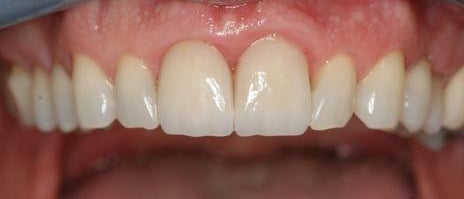
Image: The clinical image above demonstrates an excellent soft-tissue response to well-fitting all-ceramic restorations.
Limitations of all-ceramic restorations
- Limitations associated with all-ceramic restorations include proper polishing techniques required after adjustments to minimize wear of the opposing teeth.
- All-ceramic crowns may not be suitable for discolored teeth.
- Carious teeth should be restored with appropriate materials to minimize show-through and decreased esthetic results.
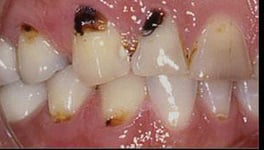
Image: The carious lesions must be excavated and restored in this clinical example before the all-ceramic crown preparations.
Tooth preparation guidelines
To be successful, all-ceramic crowns should have relatively even thickness circumferentially. This is directly related to the burs used during tooth preparation. There are only minor differences in preparations among the various all-ceramic crown materials.
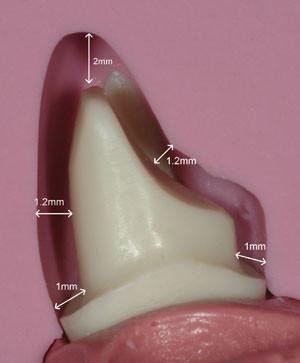 Image: Laboratory cross-section of an anterior all-ceramic crown preparation. The silicone mold identified the optimal contours for the all-ceramic restoration.
Image: Laboratory cross-section of an anterior all-ceramic crown preparation. The silicone mold identified the optimal contours for the all-ceramic restoration.

Tips for tooth preparation
- Tooth preparations should have 90° cavosurface margins to help prevent unfavorable stress distribution and minimize the risk of crown fracture.
- Anterior preparations must provide optimal support for the porcelain along its entire incisal edge. This involves a 2-plane reduction of the incisal edges. The tooth should have sufficient coronal structure for optimal resistance and retention form. Ideally, this area shouldn’t exceed a thickness of 2 mm. Otherwise, all-ceramic restorations may fail.
- Posterior tooth preparations should have 2-plane reductions on the working cusps (lingual maxillary cusps; buccal mandibular cusps).
- Posterior restorations should distribute occlusal loads evenly through the ceramic material and be supported by tooth structure.
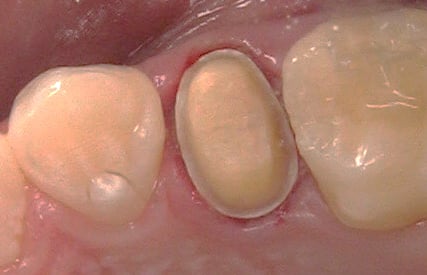
Image: Clinical image of 2-plane lingual cusp reduction of a maxillary premolar. This allows for the adequate thickness of ceramic material and minimizes the potential for ceramic fracture.
- For IPS Empress® or e.max® crowns and anterior zirconia crowns, teeth should be reduced between 1 mm and 1.5 mm to create aesthetically-pleasing restorations. The facial reduction should be between 1 mm and 1.5 mm, while incisal edges should be reduced between 1.5 mm and 2 mm to ensure sufficient incisal translucency.
Tooth Preparation
- Optimal tooth preparation should begin with depth grooves of known diameters. This is done using burs of a known diameter of approximately 1.0mm in diameter. Clinicians ensure proper occlusal reduction by connecting the grooves.
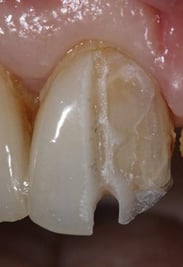
Image: The depth groove was made with a 1mm diameter diamond bur. Additional depth grooves will be prepared and joined together to finalize the preparation.
- This step is repeated on all tooth surfaces to ensure even reductions.
- Sharp line angles must be eliminated throughout the preparation.
- Margins must be precisely prepared with a 1-mm-wide circumferential shoulder or chamfer with rounded axial/gingival line angles.
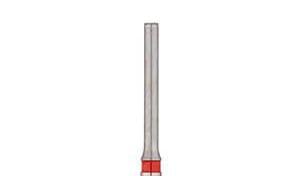 Image: This is one manufacturer’s design for preparing smooth shoulders without damaging the gingival tissues. (Brasseler 8839.31.012 FG Fine End-cutting Diamond).
Image: This is one manufacturer’s design for preparing smooth shoulders without damaging the gingival tissues. (Brasseler 8839.31.012 FG Fine End-cutting Diamond).
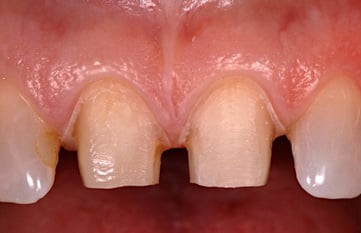
Image: Clinical example of optimal anterior all-ceramic crown preparations with 2-plane incisal edge reduction and smooth shoulder margins.
- Care should be taken to avoid creating undercuts at the junction of the shoulder and the axial walls.
- Feather edges and sharp transitions must be avoided, and the shoulder should be as smooth as possible. This can be done with an end-cutting fine diamond bur.
- A football-shaped bur can be used to reduce and shape the lingual surfaces.
After the try-in procedures
After the try-in procedures have been completed, the appearance of the restorations can be modified by the color of the luting/bonding agents. Some bonding systems have been color-coded and correlated with ceramic shades. Clinicians likely will need to experiment with these systems to obtain optimal results.
Please be reminded that our experienced technical team is here to assist you should you wish to discuss a case in more detail.
Click here to schedule a consultation with our technical team ›

References:
http://glidewelldental.com/wp-content/uploads/2016/02/all-ceramic-emax-prep-guide.pdf
https://www.slideshare.net/moatazabodief5/all-ceramic-crown-preparation-seminar
http://www.nellmarlab.com/sites/default/files/files/tooth_preparation.pdf